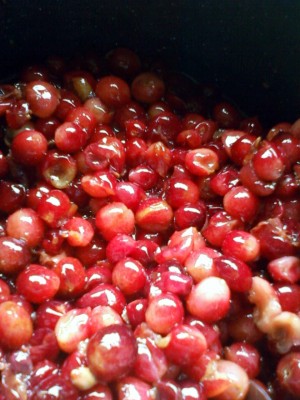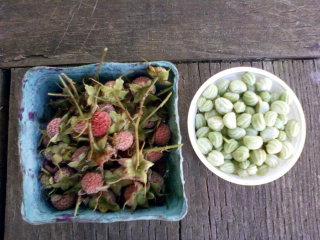
pectin-free jams sweetened with honey: marionberry lavender, blueberry lemon, whole pitted cherries in honey (not jam), strawberry-raspberry with balsamic vinegar jam, marionberry jam
i want to challenge the idea that eating well means shelling out a lot of cash. i define “well” like i’m sure many consumers do, as organic, sustainably harvested, chemical-free, obtained as locally as possible, raised as humanely as possible, the least amount of processing/additives/preservatives, and i’ll even go so far as to say, with as little plastic packaging as possible involved. there is a common assumption that this type of food is unobtainium for the typical american family. while i think we could use a little more open mindedness on what proportion of our budget gets spent on food (american values have narrowed on that point quite a bit in a few generations), i do think the well established assumption that good food has to cost more needs to be challenged.

salmon ready for smoker; 20 pounds put away; brought home from work for free after they had done their duty for science
i will admit that i do have access to a lot of amazing resources in my area for obtaining really good food for reasonable prices, but i think there are resources available to everyone, with a little legwork. even if you don’t get all glean-your-neighbors’-orchard and hunt-your-own-meat on this topic, you can still arrive at the conclusion that eating good, clean food is affordable. it is the one thing that holds so many people back from voting (with their dollars) for change (in agriculture) and i would like to invite everyone to challenge their assumptions on how much good food costs, so we can bring back the small, sustainable farms and boot the agribusinesses.

9 pounds of feral cherries picked for free, from the same place we get over 100 pounds of apples every autumn
many people could save a ton of money (and thus be able to put more money towards organic choices) by cooking more from scratch. but even if you are already eating oatmeal for breakfast every morning, there may be a way to eat organic oatmeal just as affordably, if not moreso, than you are right now. we switched from eating mostly (ready-made, pre-packaged) bagels for breakfast, to more often than not eating a big bowl of oatmeal. the bagels themselves used to be $2.79 for a package of 5, making each breakfast worth $0.56 before the cream cheese was factored in. (i just looked again, and now the bagels cost $2.79, but there are now only 4 bagels per package! yikes!) i had the sense that making oatmeal was going to provide us a cheaper, healthier breakfast alternative, but in order to be sure, i checked into the price of oats. this is just one example, but i find it very illuminating, and would love to hear back from anyone on their experiences in this sort of price-comparison.
the breakdown: steel cut oats can be purchased in a number of ways in newport. one can buy them either from the food co-op (local health food store), or from fred meyer (big supermarket chain). furthermore, in either store, there are several options. at fred meyer, you have the option of buying oats from the bulk section, where they cost $1.59 per pound, and happen to be organic (let’s assume, USDA certified organic). if you don’t want to mess with all that scooping, bagging and tagging, however, you can choose a canister of steel cut oats, at which point you have the option of cruising the conventional aisle and finding the one brand of conventional (not organic) steel cut oats nestled amidst the vast array of heavily-processed instant oatmeal options, and pay $6.49 for 24 ounces; or you can buy a bag of bob’s red mill (not organic) steel cut oats in the natural foods section at $4.99 for 24 ounces, or yet another canister, this time of organic (USDA, we’ll presume again) steel cut oats, a larger 30 ounce canister, this time for $4.29. if you’re set on a pre-packaged option, the 30 ounce canister seems like the best value, but now we’re left doing math, because our canisters come in various sizes cleverly measured in ounces, while our bulk option is priced by the pound.
i ran the math, and the price per pound for these options at fred meyer is as follows:
conventional aisle canister $4.33
natural aisle bob’s red mill (bagged) $3.33
natural aisle canister, organic $2.29
bulk, organic $1.59

eating oatmeal (with blackberry honey and red raspberries) standing up with one hand tied behind his back (jk) on market morning
rather than jumping to the all-too-familiar conclusion that everything at the co-op is more expensive, i did more homework. i have for a long while been gathering the sense that the bulk section at the co-op is, against standard public opinion, one of the better deals in town, while it is true that many packaged items at the co-op are indeed pricier than their supermarket counterparts. at the co-op, one may buy organic steel cut oats from the bulk bin for $1.45 (hey! the cheapest deal so far! and they are oregon tilth certified organic, a cut above the USDA standards). the co-op has one further option for members (the annual membership fee of $24 must be weighed in here, but divided among the member sale price savings and quite a handful of bulk purchases that i make each year, the member tax on my 25 pound bag of oats amounts to under $1.) members may purchase items in bulk through the same suppliers the co-op uses to fill their bulk bins, and pay 30% markup over wholesale, which in english means that you end up paying less than the retail price (MSRP). for a 25 pound bag of oregon tilth certified organic oats (distributed by grain millers in eugene, oregon!) the total price came to $17.91, that’s right, a whopping $0.72 per pound! per pound breakdown for the co-op (where you cannot get a canister, no matter how much extra you are willing to pay for packaging!):
co-op bulk organic $1.45
co-op bulk member purchased in 25 pound quantity $0.72
i did not expect the results to be quite so clear cut. clearly, the best option is to pay $0.72 per pound, making each breakfast for the mighty quinn and me weigh in around $0.36 (I weighed the amount we normally consume for breakfast and it came in at around a half pound). that’s before the local honey and frozen (cheap or free, local) berries or applesauce are dolloped in liberally, but still… it beats the bagels hands down! (bagels are $0.56 for each of us, without cream cheese, if you recall.) my favorite thing about this breakdown is that the cheaper, more organic options are also the ones with the less obnoxious (how the heck do you recycle an oatmeal canister anyway?) packaging.
if you’re willing to buy dry beans and grains in bulk, cook from scratch, and spend a little time in the sun gathering bucketloads of free fruit, you definitely have a financial leg up on the conventional eaters. fruit can often be gleaned from friends/neighbors/relatives’ yards, public places (a church not far from us is surrounded by blackberries), and if you tag along with, for instance, a local mushroom collecting club, you can begin to obtain some choice wild harvested goodies, often for free or a small permit fee. in addition, if you look around, you may find that you-pick farms in your area are converting to organic practices, and offering their choice fruits at a fraction of the price of ready-picked fruit. we paid $0.90/lb for organic strawberries this season, $1.50/lb for organic marionberries as well as blueberries, and are looking forward to picking organic peaches soon. our cherries, blackberries, red raspberries, and apples are all free range, and at a price that can’t be beat: free! (transportation costs apply in some cases, but often we split those with friends, or stack our errands when we make a drive, so they run to the negligible side of things.)
be creative! i work with juvenile salmon smolts at my job, and have come home with some of our larger juveniles after they have been measured and studied and are headed for the landfill. some folks will take home fish to feed their pets or chickens, and some of us are brave (poor?) enough to supplement our own diets. even if this option is extreme for you, buying a whole fish from a boat (if you are coastal) and freezing or canning portions is a far thriftier option than buying a fresh (or frozen, packaged) cut each time you want fish. the going price for albacore tuna (whole) is roughly $2.50-2.75 per pound in newport, and that gets you meat at about $5/pound once all the bones and skin are removed. most canned, frozen, and fresh fish counter fish come in substantially higher than that. (hint: ask the person who fillets your fish on the boat to bag your tuna carcass, and use it as crab bait to turn it into even more choice, local, goodness!)
another part of our diet where i have dramatically cut costs by eating better food is in the dairy department. by making our own yogurt and soft cheeses, and more recently feta (yum!), we have been able to switch to entirely raw (local, organic-ish) goat milk for these purposes, which at $4 per half gallon may at first glance seem pricey. however, when a gallon of milk makes a tub of yogurt and several pounds of chevre (think cream cheese), the extra cost quickly disappears and turns into a savings. (foodie alert! people will pay top dollar for a teensy 4 ounce package of chevre! several pounds is a gold mine!)
there are many ways to stretch your food budget by eating your weeds as well- stinging nettle is by far my favorite green, and it’s not generally something money can even buy! it’s hard to put a value on the seasonal treats we enjoy around here that we freely forage: thimbleberries, edible flowers, pickled nasturtium seeds, the possibilities are limitless.

thimbleberries and nasturtium seeds- i learned a neat trick recently. you can pick thimbleberries under-ripe and they will ripen on your kitchen counter! awesomeness!
finally, there is our garden and csa membership, which save us a ton of money on the very best local, seasonal, organic produce available. for me, these examples are ample evidence of what i’ve been suspecting is afoot. the hidden costs behind conventional and non-local (petroleum subsidized), non-seasonal (ditto), chemical-laden (ahem, is there an echo?), foods are coming out of hiding and showing up in the prices we pay at the supermarket, and the real value of whole foods is becoming more readily apparent in terms of dollar signs… if we decide to do a little updated comparison shopping now that we have entered the era of peak oil, who knows what we might find out?
how does this compare with your experiences of choosing cleaner food options? have you done similar price comparisons? if you care to share below, please add links or comment here about this topic. knowledge is power!


















Brilliant! I agree with all that you've said here. I've never actually done the math for myself, but am certain that I would have similar results to what you calculated. While I think that it's important to acknowledge that there are very real barriers to eating a sustainable diet (one must own the implements with which to cook and have the time to do so, for example) I think that you've demonstrated some very entry level ways of actually saving money (and more healthfully!) by eating organic. As you've shown, there are small steps that we can all take, which frees up more of our food dollars to make better choices, and it snowballs from there. Bravo!
cpcable recently posted..Zucchini…Still
thank you for that- i definitely agree that i am still very much speaking from a place of privilege, that i have the option to cook food from scratch for myself. i wanted to make that point more clearly, and ended up leaving it pretty vague, so i am glad you chimed in!
I loooooooove that you posted this! I want to print it and pass it around work when they call me crazy for making my own cheese and yogurt. I've begun buying in bulk as well- especially quinoa and amaranth. Each goes for about $4.99 a pound packaged but if I hit the sales at Sunflower Market I can get them for $1.99 a pound in bulk. Since becoming vegetarian these are huge parts of my diet and it is ridiculous that I am paying $3.00 for packaging and marketing. You are a lucky girl to have so much free range fruit 🙂
Now if you find you have the odd oatmeal container, I know a certain floppy eared bunny who can extract literally hours of fun from them 🙂
yessss! even oatmeal containers have reuse value! sweet! 🙂
I love this post! I found your blog over at That Mama Gretchen for Wool Week. I grew up in the NW and now live abroad. We have some great local markets around where I live and I love being able to purchase fresh food from them. Now if I could only get my garden to grow… 🙂
Jamie
hi, jamie! thanks for stopping by! i love that this particular post caught your eye, it's such a great topic. my life pretty much revolves around food lol.